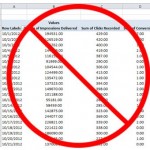 A poor campaign tracking strategy will leave you scratching your head when the report arrives. Discontinuities in your data will make you ask questions that are almost impossible to answer. No floodlight tags, search tags,web analytics platform tags will drive your team crazy. The executive team will want to see ROI (Return On Investment) numbers, and all you will have is impressions, clicks, click through rates, and view-through metrics.
A poor campaign tracking strategy will leave you scratching your head when the report arrives. Discontinuities in your data will make you ask questions that are almost impossible to answer. No floodlight tags, search tags,web analytics platform tags will drive your team crazy. The executive team will want to see ROI (Return On Investment) numbers, and all you will have is impressions, clicks, click through rates, and view-through metrics.
Pitfalls in tagging fall into 3 major groups: lack of tags, too many tags, and not tagging lower funnel actions. Each of these pitfalls is usually due to poor initial strategy or implementation. Campaigns that have a strong measurement and tagging process end up having a better chance at optimizing media towards conversion.
The Lack of Tags Pitfall
When you see multi-million dollar campaigns launched without any DoubleClick floodlight tags, search tags, and web analytics platform tags you know there is an issue in the planning and process phases. This usually means that project management does not recognize that tagging is an important part of campaign launch strategy. Campaign managers need to have strong tagging matrix to align where tags need to be placed on each page of the campaign landing page. Having a single tag on the home page of your campaign is helpful in understanding the traffic that arrives from click through and view through of your ads. However, it leaves a lot to be desired when answering the question of what happened next.
Too Many Tags Pitfall
This pitfall is a little better than having no data, however the strategy is somewhat wasteful. It is wasteful because not all elements of the page that a user sees and clicks on are important to your campaign strategy. Meaning, if you are selling Green Widgets in your ads, driving the user to the Green Widgets page, it may not be necessary to tag the Purple Widgets page as it has no meaning to your campaign outcome. Additional tags just add confusion for the IT team that is implementing tags and the media analytics team that is trying to decide what the Purple Widget has to do with your campaign.
Not Tagging Lower Funnel Actions
Tagging upper funnel pages and events is useful. It allows you to see what pages people brows and what events users take. However, it does not help you understand the ROI of your campaign. This is because a person that browses your site does not provide a causal relationship for purchase. Perhaps their purchase intent increases, but that does not necessarily imply a purchase. Lower funnel tags allow you to get closer to understanding purchase causality on your site.
Tagging lower funnel actions means tagging forms for lead generation pages and their form submission confirmation pages. For eCommerce sites it meas tagging every step in the shopping cart funnel. Combining upper funnel tags, with lower funnel tags provides you with several really important metrics:
- Funnel or Form Conversion Rate
- Unique Visitor to Conversion Rate
- Form or Shopping Cart Drop-off areas
All of these allow you to identify areas to improve upon during your campaign.
Conclusion
I can go on and on about creating tagging matrixes and measurement plans for media campaigns. But it takes an experienced media person with understanding of DoubleClick search and display tags to get it right. I will speak more to project management and communication of media tagging matrix’s and measurement and learning plans in future blog posts.
Related Posts: Why use custom floodlight tags in Digital Display Advertising, Data Driven Answers to difficult executive questions